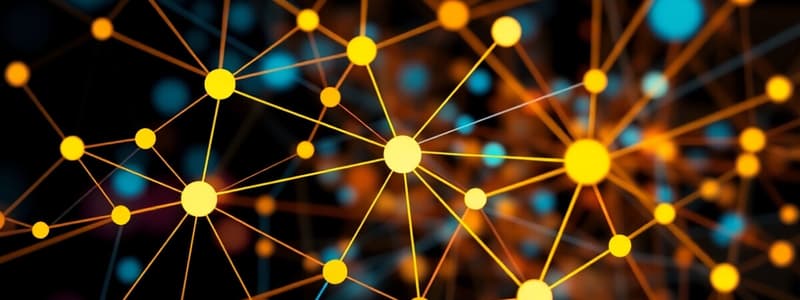Podcast
Questions and Answers
What is a major disadvantage of linear bus topology?
What is a major disadvantage of linear bus topology?
- Collisions can occur when multiple devices transmit simultaneously (correct)
- Performance is not affected by cable breaks
- High cost of installation and maintenance
- It requires more cables than star topology
How does a switch improve network performance compared to a hub?
How does a switch improve network performance compared to a hub?
- It maintains a table of MAC addresses for efficient data forwarding (correct)
- It connects devices in a linear bus configuration
- It forwards data to all connected devices
- It uses IP addresses for data transmission
What is the function of a DHCP server?
What is the function of a DHCP server?
- To automatically assign IP addresses to devices (correct)
- To manually configure IP addresses for devices
- To assign MAC addresses to network devices
- To maintain a record of all connected devices
In which scenario would a ring topology be less efficient?
In which scenario would a ring topology be less efficient?
What distinguishes a MAC address from an IP address?
What distinguishes a MAC address from an IP address?
What is one of the primary purposes of Network Address Translation (NAT)?
What is one of the primary purposes of Network Address Translation (NAT)?
Which topology offers the best centralized management and troubleshooting capabilities?
Which topology offers the best centralized management and troubleshooting capabilities?
Why is a hub considered less secure than a switch?
Why is a hub considered less secure than a switch?
Which of the following statements about IP addresses is true?
Which of the following statements about IP addresses is true?
Flashcards
Linear Bus Topology
Linear Bus Topology
A network topology where all devices are connected to a single cable.
Ring Topology
Ring Topology
A network topology where devices are connected in a closed loop.
Star Topology
Star Topology
A network topology where all devices connect to a central device, like a switch or hub.
Switch
Switch
Signup and view all the flashcards
Hub
Hub
Signup and view all the flashcards
MAC address
MAC address
Signup and view all the flashcards
IP address
IP address
Signup and view all the flashcards
DHCP Server
DHCP Server
Signup and view all the flashcards
Network Address Translation (NAT)
Network Address Translation (NAT)
Signup and view all the flashcards
Linear Bus Topology Disadvantage
Linear Bus Topology Disadvantage
Signup and view all the flashcards
Study Notes
Computer Network Topologies
-
Linear Bus Topology: All devices are connected to a single cable.
- Disadvantages: If the cable breaks, the entire network fails.
- Collisions occur when multiple devices try to transmit data simultaneously, reducing performance.
-
Ring Topology: Devices are connected in a closed loop.
- Advantages: Better performance than a bus topology.
- Disadvantages: If there is a break anywhere in the loop, the entire network fails.
-
Star Topology: All devices connect to a central device, typically a switch or hub.
- Advantages: More reliable than bus or ring topologies.
- Enables centralized management and better troubleshooting.
- Switch/hub handles data forwarding efficiently, directing it only to the intended recipient, increasing performance.
Switch vs. Hub
-
Switch:
- A switch maintains a table of MAC addresses (unique to each device) and their corresponding ports.
- It forwards data only to the intended recipient's port, avoiding broadcasting to all devices.
- The switch uses MAC addresses for data transmission, not IP addresses.
-
Hub:
- Hubs broadcast data to all connected devices.
- Increases network bandwidth consumption due to unnecessary data transfer.
- Less secure as all devices can see the network traffic.
Network Identification
-
MAC address: A unique, 48-bit identifier burned into each network interface card (NIC).
- Used for local network communication.
- Not changed easily.
- Allows the switch to identify and forward data to specific connected devices.
-
IP address: A 32-bit identifier that allows devices to communicate across networks, including the internet.
- Used for routing and addressing on the internet.
- Can be assigned manually or automatically through a DHCP server.
- Used in conjunction with the MAC address, as a switch only knows MAC addresses.
DHCP Server
- DHCP (Dynamic Host Configuration Protocol): A service that automatically assigns IP addresses to devices.
- Used for easy and efficient network management.
- Allows devices to join the network and obtain an IP address without manual configuration.
Network Address Translation (NAT)
- NAT: A technique used by routers to translate IP addresses within a private network to a single public IP address.
- Hides the internal network infrastructure from the outside.
- Conserves public IP addresses, which are limited.
- Increases network security by preventing direct access to internal devices from the internet.
Port Forwarding
- Port forwarding: Allows specific ports on a router to be forwarded to a specific device within the local network, making those services public.
Copy Tracer
- Copy Tracer: A network simulation software that allows users to practice configuring network devices and run tests and troubleshooting.
- Allows for hands-on experience with network configuration.
- Can be used to design and test network topologies.
- Offers the ability to export configurations to real Cisco devices.
Studying That Suits You
Use AI to generate personalized quizzes and flashcards to suit your learning preferences.




